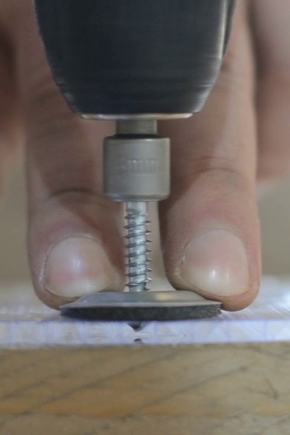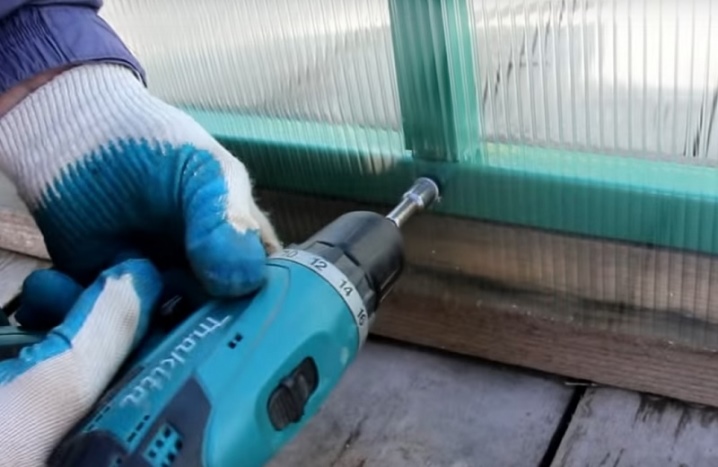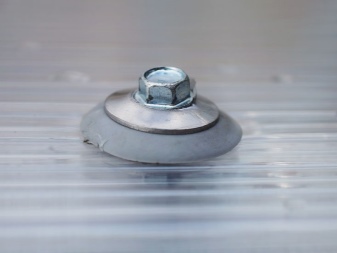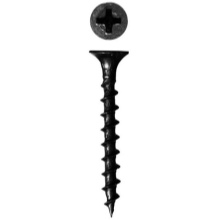Varieties of self-tapping screws for polycarbonate and their fasteners

Special self-tapping screws for polycarbonate appeared on the market with the growing popularity of this material. But before fixing it, it is worth studying the features of installing fragile panels, choosing the appropriate size and type of hardware for the greenhouse. It is worth talking in more detail about the difference between self-tapping screws with a thermal washer and conventional options for wood, other types of fasteners.

Peculiarities
Greenhouses with walls and a roof made of polycarbonate managed to win fans in many regions of Russia. Besides, this material is widely used in the construction of sheds, canopies, temporary and advertising structures; extensions and verandas are made of it. Such popularity leads to the fact that craftsmen have to look for the optimal hardware for assembling these structures. And here certain difficulties arise, because when fixing, the correct position and free adhesion of the sheets is very important - due to thermal expansion, they simply crack when tightened too much.
The self-tapping screw for polycarbonate is a metal product for through-fixing the material on the frame. Depending on what kind of material is used as a base, hardware for wood and metal is distinguished. Additionally, the package includes a gasket and a sealing washer - they are needed in order to avoid damage to the structure.


Each of the components of the hardware performs its own function.
- Self-tapping screw. It is needed in order to connect a sheet of polymer material to the frame to which it needs to be attached. Thanks to him, polycarbonate withstands wind gusts and other operational loads.
- Sealing washer. Designed to increase the contact area at the junction of the screw and sheet. This is important because the metal head can compromise the integrity of the sheet material. In addition, the washer compensates for the stresses caused by thermal expansion. This element consists of a "body", a cover for protection from the external environment. Materials for its manufacture are polymers or stainless steel.
- Pad. It acts as a dock shelter. Without this element, condensation can accumulate at the junction, causing the formation of rust that destroys the metal.

When fixing polycarbonate - cellular or monolithic - sheets cut to the required size are most often used. The fixation is carried out with or without pre-drilling the hole. Self-tapping screw can have pointed tip or drill at its bottom.

Species overview
You can use different types of self-tapping screws for assembling the greenhouse or for fixing sheet material as a canopy roof, veranda or terrace walls. Sometimes even roofing options with a rubber washer are used, but more often options with a press washer or with a thermal washer are used. A self-tapping screw differs from other hardware (screws, screws) in that it does not require preliminary preparation of the hole. It cuts into the thickness of the material, sometimes a tip in the form of a miniature drill is used to enhance the effect.
The difficulty of attaching polycarbonate is that it is impossible to use nails or staples, rivets or clamps. Here, only self-tapping screws are relevant, capable of providing a neat and strong fastening of sheets to the surface of the frame. How they differ is worth talking in more detail.

By wood
For wood screws, a rather wide step is characteristic. Their cap is most often flat, with a cross-type slot. Almost any type of polycarbonate, galvanized and ferrous, is suitable for polycarbonate. You can choose only according to the correspondence of the diameter to the hole in the thermal washer, as well as according to the desired length.
High contact density allows wood screws to securely fasten the frame part and polycarbonate. But the products themselves, if they do not have an anti-corrosion coating, need additional protection from external factors.



For metal
Self-tapping screws intended for fastening to a metal frame have a wide head, most often they are covered with a layer of zinc, which protects the hardware from corrosion. They can have a pointed tip - in this case, the hole is pre-drilled. Such hardware is quite popular. The drill bit options are suitable for working without first punching a hole or recess in the frame.
Self-tapping screws for metal are initially more durable. Considerable efforts are made to screw them in. The hardware must withstand them without breakage or deformation. Self-tapping screws in white - galvanized, also yellow, coated with titanium nitride.
Sometimes other types of hardware are used to fix polycarbonate. Most often, roofing screws with a press washer are used for a snug fit.



Classification by head design
Complete with sheet polycarbonate, self-tapping screws are most often used, which can be fixed with a screwdriver. They can have a flat or convex cap. It is also permissible to use hex options. The most commonly used hardware is with the following hats.
- With cruciform slot for the bit. Such splines are marked as Ph ("phillips"), PZ ("pozidriv"). They are the most common.
- With faces for a head or open-end wrench. They can additionally have cross-type slots on the head.
- With a hexagonal recess. Self-tapping screws of this type are considered vandal-proof; when dismantling them, a special tool is used. You cannot simply unscrew the hardware with a screwdriver.
The choice of the shape and type of the cap remains solely with the master. It depends on the tool used. The type of head does not affect the density of the polycarbonate sheets too much.
The use of a thermal washer compensates for the difference in the contact area of different types of hardware.



Dimensions (edit)
The standard range of polycarbonate thickness ranges from 2mm to 20mm. Accordingly, when choosing self-tapping screws for fixing it, this factor should be taken into account. In addition, thermal washers also have their own dimensions. They are designed for fasteners with a rod diameter of no more than 5-8 mm.
The standard dimensional parameters of self-tapping screws vary in the following range:
- length - 25 or 26 mm, 38 mm;
- rod diameter - 4 mm, 6 or 8 mm.
The focus should be on the diameter. The fragility of polycarbonate, especially its honeycomb variety, requires special care when choosing the diameter of the hole. Practice shows that the optimal size is 4.8 or 5.5 mm. Larger options cannot be combined with a thermal washer, and cracks remain in the wooden frame from them.
An insufficiently thick rod can break or deform under stress.



As for the length, the thinnest sheets of material of 4-6 mm are easily fixed with self-tapping screws 25 mm long. This will be enough to ensure a strong connection to the base. The most popular material for greenhouses and sheds has a thickness of 8 and 10 mm. Here, the optimal length of the self-tapping screw is 32 mm.
Calculating the appropriate parameters is fairly easy using the formula. You need to add the following indicators:
- frame wall thickness;
- sheet parameters;
- washer dimensions;
- a small margin of 2-3 mm.
The resulting figure will correspond to the length of the self-tapping screw that you need to choose.If the resulting version does not have an exact analogue among the standard sizes, you will have to select the closest replacement.
It is better to give preference to the option slightly less than to get the result in the form of protruding tips of fasteners in the frame.

How to fix it correctly?
The process of installing polycarbonate without special profiles begins with calculating the number of hardware - it is determined per sheet based on the selected fastening step. The standard distance varies from 25 to 70 cm. It is better to visualize the marking - to apply it in the places where the master will screw the fasteners using a marker. For a greenhouse, a step of 300-400 mm will be optimal.
The subsequent actions look like this.
- Hole preparation. It can be done in advance. Polycarbonate should be drilled by placing it on a flat, flat surface of the base. The hole diameter must match the inner dimension of the thermal washer.
- Polycarbonate edge protection. Remove the film from the attachment points. Place the material on the frame with an overhang of no more than 100 mm.
- Joining of sheets. If the width is insufficient, overlap joining is possible, with longer self-tapping screws.
- Installation of self-tapping screws. A thermal washer with a gasket is put on them, inserted into the holes on the polycarbonate. Then, with a screwdriver, it remains to fix the hardware so that there are no dents on the material.


By following these simple instructions, you can fix the polycarbonate sheet to the surface of a metal or wood frame without risking damaging it or destroying the integrity of the polymer coating.
You can learn how to properly attach polycarbonate to profile pipes from the video below.













The comment was sent successfully.